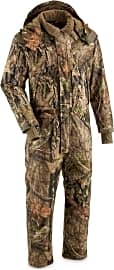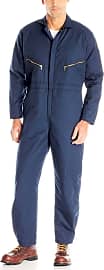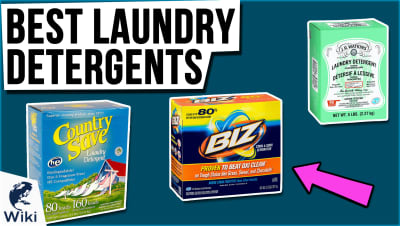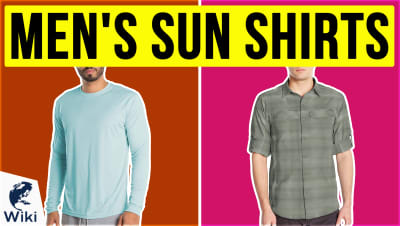The 10 Best Men's Insulated Coveralls

This wiki has been updated 41 times since it was first published in December of 2016. If you work in a messy or dirty outdoor environment, you'll want to check out these men's insulated coveralls. We've included a wide variety of designs to suit many needs, but we made sure they all have the strength and durability to withstand oil, water, muck, and cold, all while providing you with comfort and the capability to bend, kneel, and move without restrictions. When users buy our independently chosen editorial selections, we may earn commissions to help fund the Wiki.
Editor's Notes
December 15, 2020:
In our most recent update, we removed the Carhartt X01, the ScentLok Savanna Quickstrike, and the Walls Blizzard-Pruf due to availability concerns and replaced them with the Carhartt Arctic, the Guide Gear Waterproof, and the Walls Zero-Zone. For people who want coveralls for hunting, the Guide Gear Waterproof is the way to go. Not only are they camouflage, the fabric is incredibly quiet so you can stay stealthy on your hunt. They're also a waterproof option, so you can immerse yourself in wet environments without worrying about getting soggy.
The Walls Zero-Zone, on the other hand, aren't waterproof, but would be a great option for folks who need to wear coveralls on a job site. They have pleats in the back for increased movement and the many pockets make it easy to carry pencils, notes, and other things you need on hand. The Carhartt Arctic have moved to the second spot because of their balance between durability, weather-resistance, versatility, and price.
April 06, 2019:
Insulated coveralls do a lot more than simply provide warmth. In this list, you'll find styles that boast useful extras such as waterproofing, roomy pockets, hoods, and more, all of which are likely to come in handy on the job site. There are also coveralls intended for specific recreational activities, like the ScentLok Savanna Quickstrike — the perfect solution for hunters who live in chilly regions. The Guide Gear Dry Hunt and Five Rock Deluxe were removed due to fulfillment and quality concerns, while the Walls Blizzard-Pruf has been promoted to the second spot because of its comfortable and dependable design.
Covering Your Bases
Look for materials that can handle the demands of your workplace, and you're halfway to a good choice.
Men's insulated coveralls are resilient garments made for tough work or play environments. They can protect mechanics against dangerous spills or sparks, keep hunters warm and dry, and help save everyday clothing from rips and tears. Before you get the best benefits, however, you'll need to ensure that you choose the right pair for your particular situation.
It's a safe bet that topping your priorities are those features that will keep you safe and comfortable in your environment. This is where the fabric enters the picture. Is it flame resistant? How vulnerable is the material to rips and abrasions? How thick is the insulation? Look for materials that can handle the demands of your workplace, and you're halfway to a good choice. Then, you're ready to look at the garment's overall construction. Extra padding and fabric at the knees and elbows will add to durability, as will reinforced seams. These may seem like small touches, but they can make a difference in how long your new coveralls last.
You'll also want to look at the extra features integrated into a pair of coveralls. Pockets are virtually a must, but how many do you need? And should they open with zippers, snaps, or nothing at all? What about a hammer loop or the ability to add a hood? Do you prefer loose cuffs or elasticated? The best men's coveralls generally feature some way of opening the pant legs, either a zipper or snaps, allowing you to put them on over work boots.
Then there's fit, which is just as crucial as features. You don't want to end up like a sausage stuffed in a casing, after all. You'll notice that manufacturers generally offer sizing charts that explain their sizes. To use these effectively, you'll need to actually get out a measuring tape instead of guesstimating. If you're between sizes, you'll probably want to choose the larger of the two for comfort. If the sleeves or legs are too long, you can consult with an experienced tailor about shortening them.
Finally, don't forget about care. Are they machine washable or treated to resist stains? Can they go in the dryer? Don't forget that insulated coveralls are usually quite heavy, so drying time is an important factor; you don't want to be heading for work feeling damp and uncomfortable.
Temperature Control
It's been said that there is no bad weather, only inappropriate clothing. Working in extreme environments, hot or cold, you'll doubtless find this true, and that's why we've got some tips to have you layering like an old pro. Just keep in mind that if insulated coveralls are part of your PPE in environments with high risk for fire or chemical burns, you may be required to choose flame-resistant clothes to go underneath them.
For cold weather work, your insulated coveralls will function as your outer layer, the one designed to protect you against the wet and wind. But staying warm doesn't stop there. You'll need at least two other layers, the base and the mid. The first wicks moisture away from your skin, preventing your sweat from making you cold, while the second adds insulation, preventing your body heat from escaping. For your base, look for synthetics, merino, or even silk; for the mid layer, fleece or wool are excellent choices. Avoid cotton, as it doesn't have the insulating properties you need to stay warm and can even make you colder as you perspire.
If you must wear insulated coveralls in hot weather, cotton becomes more useful, as it will absorb sweat and help cool your skin. Or, you can look for athletic gear made specifically to wick moisture and keep your temperature down. Whichever you choose, opt for light colors that won't absorb heat should you wish to slip out of your coveralls for some air.
No Stain, No Pain
If you're in the market for coveralls, it's likely that you find yourself in dirty environments that are treacherous for your clothes. Coffee, grease, blood — they all create stains that age your coveralls quickly. Fortunately, there are plenty of household items that are excellent stain fighters. The trick is knowing which stain to match with what cleaning agent.
As soon as you can, rub liquid laundry detergent into the affected area, then soak it in cold water.
Grease, for instance, requires you to bust out the dishwashing liquid, which makes sense if you think about it — dishwashing liquid is made to handle your greasy pots and pans. Rub it into the affected area using either your hands or an old toothbrush. Let this sit for five or 10 minutes, then wash with laundry detergent as usual.
Blood can be trickier, as preventing a stain requires removing the blood before it has a chance to dry completely. The first thing to do is rinse the affected area with cold water, as hot or warm can actually set the stain. Then, apply ammonia, hydrogen peroxide, or vinegar, whichever you have on hand. After you wash the coveralls, there shouldn't be any traces of blood left. If there are, you can try treating the area with ammonia, hydrogen peroxide, or vinegar again.
Coffee is perhaps one of the most stubborn stains. After the spill, blot the area with a paper towel to remove the moisture. As soon as you can, rub liquid laundry detergent into the affected area, then soak it in cold water. Every five minutes, rub the area to loosen the stain. After 30 minutes, the garment is ready for washing. If this doesn't remove the stain, try the same procedure, only use a paste made from white vinegar mixed with powdered laundry detergent. Vinegar is a great help in removing deodorant stains, as well. Before you use vinegar or any other cleaning agent, place it on an unnoticeable area of the coveralls first to test for potential discolorations.















